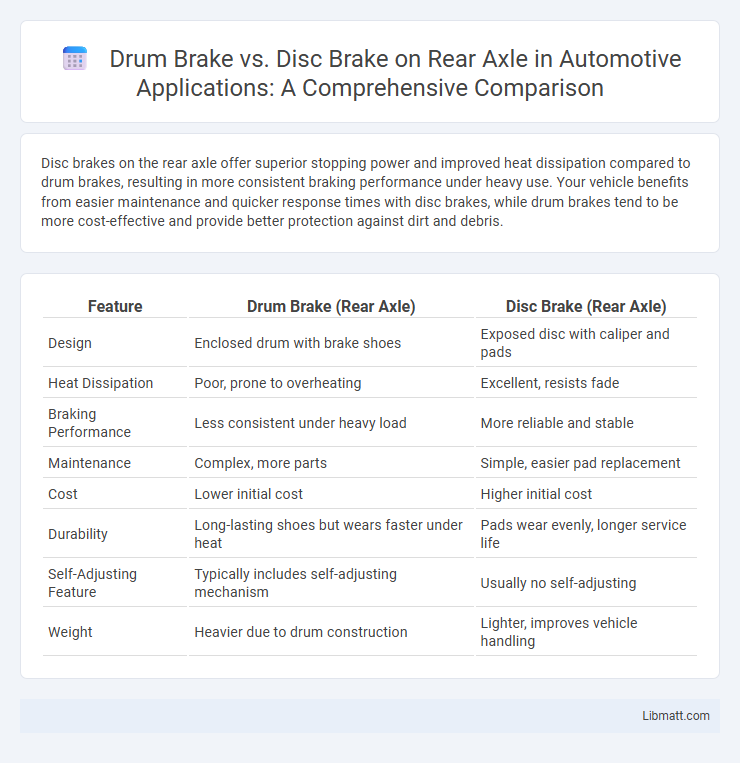Disc brakes on the rear axle offer superior stopping power and improved heat dissipation compared to drum brakes, resulting in more consistent braking performance under heavy use. Your vehicle benefits from easier maintenance and quicker response times with disc brakes, while drum brakes tend to be more cost-effective and provide better protection against dirt and debris.
Table of Comparison
| Feature | Drum Brake (Rear Axle) | Disc Brake (Rear Axle) |
|---|---|---|
| Design | Enclosed drum with brake shoes | Exposed disc with caliper and pads |
| Heat Dissipation | Poor, prone to overheating | Excellent, resists fade |
| Braking Performance | Less consistent under heavy load | More reliable and stable |
| Maintenance | Complex, more parts | Simple, easier pad replacement |
| Cost | Lower initial cost | Higher initial cost |
| Durability | Long-lasting shoes but wears faster under heat | Pads wear evenly, longer service life |
| Self-Adjusting Feature | Typically includes self-adjusting mechanism | Usually no self-adjusting |
| Weight | Heavier due to drum construction | Lighter, improves vehicle handling |
Introduction: Drum vs Disc Brakes on Rear Axle
Drum brakes on the rear axle feature a set of brake shoes that press outward against a spinning drum, providing reliable stopping power and cost-effective maintenance. Disc brakes, by contrast, use calipers to squeeze brake pads against a rotor, offering improved heat dissipation and more consistent performance under heavy braking conditions. Your choice between drum and disc brakes on the rear axle can impact vehicle handling, braking efficiency, and long-term durability depending on driving habits.
How Drum Brakes Work
Drum brakes operate by using brake shoes that press outward against a spinning drum attached to the wheel, creating friction to slow or stop the vehicle. When you apply the brake pedal, hydraulic pressure forces the shoes to expand inside the drum, converting kinetic energy into heat. This mechanism is typically found on the rear axle due to its cost-effectiveness and ability to provide strong braking force in low-speed conditions.
How Disc Brakes Work
Disc brakes on the rear axle function by using calipers to squeeze brake pads against a spinning metal rotor attached to the wheel, creating friction that slows or stops the vehicle. This friction converts kinetic energy into heat, which is dissipated quickly due to the exposed design and ventilated rotors, enhancing braking efficiency and reducing fade. Compared to drum brakes, disc brakes provide more consistent stopping power, improved heat dissipation, and better performance in wet conditions.
Performance Comparison: Stopping Power
Disc brakes on the rear axle provide superior stopping power compared to drum brakes due to better heat dissipation and more consistent friction surface contact. Drum brakes tend to fade under heavy braking because heat buildup reduces friction effectiveness, leading to longer stopping distances. The enhanced performance of rear disc brakes improves overall vehicle safety by maintaining reliable deceleration even during prolonged or aggressive braking conditions.
Heat Dissipation and Fade Resistance
Disc brakes on the rear axle offer superior heat dissipation compared to drum brakes due to their open design and exposed rotors, which allow for faster cooling during heavy braking. Drum brakes tend to retain more heat within their enclosed structure, increasing the risk of brake fade under extended use or high-temperature conditions. As a result, disc brakes provide better fade resistance, maintaining consistent braking performance even under demanding situations like steep descents or rigorous driving.
Maintenance and Durability
Drum brakes on the rear axle typically require more frequent maintenance due to their enclosed design, which can trap dust and debris, leading to faster wear and potential adjustments. Disc brakes offer superior durability with better heat dissipation, reducing the likelihood of brake fade and extending component lifespan. Maintenance for disc brakes is generally simpler, involving straightforward pad replacement and less frequent adjustments compared to drum brakes.
Cost and Affordability
Drum brakes on the rear axle are generally more cost-effective due to simpler design and lower manufacturing expenses compared to disc brakes. Maintenance and replacement parts for drum brakes are typically cheaper, making them a budget-friendly choice for economy vehicles. Disc brakes, while pricier upfront, often offer better performance and longevity, which can justify the higher initial investment over time.
Vehicle Applications and Suitability
Drum brakes are commonly used on the rear axle of economy cars, light trucks, and older vehicles due to their cost-effectiveness and durability in moderate braking scenarios. Disc brakes offer superior stopping power, heat dissipation, and performance under heavy loads, making them more suitable for high-performance cars, SUVs, and vehicles frequently driving in hilly terrain. Your choice between drum and disc brakes heavily depends on the vehicle's weight, intended use, and required braking efficiency.
Safety Considerations
Disc brakes on the rear axle typically offer superior safety performance due to better heat dissipation and more consistent stopping power under heavy braking conditions compared to drum brakes. Drum brakes may suffer from brake fade during prolonged use, which can compromise your vehicle's ability to stop effectively in emergencies. Ensuring your rear brake system maintains optimal functionality enhances overall vehicle safety and control.
Conclusion: Choosing the Right Rear Brake System
Choosing the right rear brake system depends on your vehicle's specific needs and driving conditions. Drum brakes offer cost-effective durability and strong holding power ideal for parking, while disc brakes provide superior heat dissipation and consistent stopping performance under heavy loads. Your decision should balance maintenance preferences, braking efficiency, and overall safety requirements for optimal rear axle performance.
Drum brake vs Disc brake (on rear axle) Infographic

 libmatt.com
libmatt.com